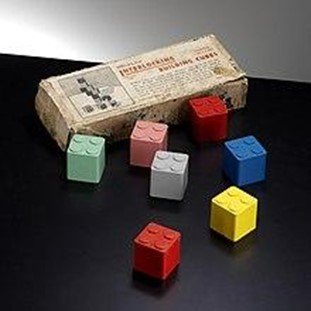What Will You Make? – How the Lego Brick was Developed
By Ben Bryant, Third Year History
Lego began life not as a brick, but as a block. In 1932, in a humble workshop in Billund, Denmark, the carpenter Ole Kirk Christiansen began to make and sell wooden toys. The business came to be called Lego, taken from the Danish phrase leg godt, meaning ‘play well’. The company only expanded into making plastic toys in 1947, before producing the first version of the iconic, interlocking plastic brick in 1949. These were based on the Interlocking Building Cube design, created by Hilary Page and Kiddicraft in 1939.
By 1951, plastic toys dominated the output of Lego, making up half of the company’s output. Although the Danish magazine ‘Toy Times’ believed that plastic would never replace traditional wooden toys, Lego was a clear exception, and Christiansen’s son, Godtfred, believed in the power of the Lego brick. By 1958, the modern Lego brick design that kids and adults alike know and love was developed. It was made from acrylonitrile butadiene styrene (ABS) and was able to lock together with ease. This led Godtfred to apply for a patent in Denmark on 28 January 1958 for the standard, two-by-four, eight-stud Lego brick, before expanding the patent globally in the coming years.
Since then, Lego has been a major player in the international toy market. In 2015, marketing consultation company Brand Finance even went so far as to say that Lego is the “world’s most powerful brand”, overthrowing Ferrari. Their demographic is near limitless. 1969 saw the introduction of Duplo, a series of bricks and sets aimed at younger children. In 1978, Lego expanded outside of bricks and introduced the classic minifigure. These inclusions literally created the building blocks for Lego’s international fame today.
Since the 1950s, many of Lego’s bricks and sets have revolved around themes. These have included space, pirates, castles, cowboys, dinosaurs - the possibilities for Lego sets are limited by the imagination of the development teams, and indeed the imagination of the builder. Lego has also gained access to various licenses of incredibly popular franchises, such as Batman, Star Wars, The Lord of the Rings and Harry Potter. These sets have not only been incredibly successful, so much so that Lego expressed a desire in 2015 to return to their own independent themes, but they have also resulted in many sets reaching collectable status and being worth a considerable amount of money.
Lego’s influence expands to an increasingly impressive degree outside of the toy market. In 1968, the world’s first Legoland opened in Billund, Denmark – now one of eight – an amusement park with the goal of celebrating the Lego brand through rides and play areas. In 1997, Lego took to the video game market, releasing Lego Island, before their industry-changing partnership with Traveller’s Tales in 2005, leading to the release of titles like Lego Star Wars: The Video Game, Lego Indiana Jones: The Original Adventures, and the critically acclaimed Lego Marvel Super Heroes. From movies like the aptly titled The Lego Movie to televised competitions like Lego Masters, Lego’s reach is near limitless.
In 2011, on the final flight of Space Shuttle Endeavour, the astronauts of mission STS-134 carried with them a most unlikely passenger. One of Endeavour’s many missions was to bring 13 Lego kits to the International Space Station, where its six astronauts would build models to see how the Lego bricks would react in microgravity. This is just one of a vast number of examples displaying the cultural significance of the Lego brick. Since its patenting on this day, 67 years ago, the humble Lego brick has encouraged generations of children and adults to be creative, innovative, and above all, to ‘play well’.
Edited by Elizabeth Abbott




